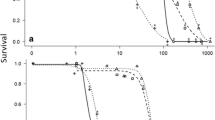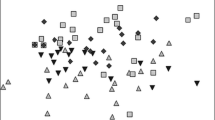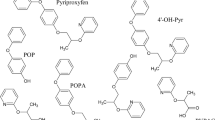Abstract
The disruption of endocrine systems due to environmental contaminants potentially impacts on the developmental, behavioural, regulatory and reproductive systems of animals. A major source of exposure of animals (terrestrial and aquatic) to endocrine-disrupting compounds is through contact with contaminated surface waters contaminated with sewage effluent and/or stormwater discharge. We studied the response to endocrine-disrupting compounds of Gambusia holbrooki mosquito fish resident of wetlands that were used for the storage of either treated sewage effluent or stormwater runoff. We found that fish from wetlands that received polluted waters directly from the source (treated sewage effluent or stormwater runoff) demonstrated a morphological response consistent with endocrine disruption. In contrast, fish in the second in the series of wetlands that housed treated sewage effluent did not show evidence of such response. However, those from the second in the series of stormwater receiving wetlands did display a morphological response, although it could be considered milder than was observed in fish from the first in this effluent stream. Fish were also smaller in the wetland that received sewage effluent directly from the sewage treatment plant than elsewhere. Although the differences were not statistically significant, the average size of fish in the first in the series of stormwater wetlands were also small and second only to those in the first sewage effluent wetland.







Similar content being viewed by others
References
ABS. (2010). 2006 Census QuickStats: Richmond (Hawkesbury) (State Suburb). Canberra: Australian Bureau of Statistics. http://www.censusdata.abs.gov.au/ABSNavigation/prenav/LocationSearch?collection=Census&period=2006&areacode=SSC18644&producttype=QuickStats&breadcrumb=PL&action=401. Accessed 3 April 2010.
Angus, R. A., McNatt, H. B., Howell, W. M., & Peoples, S. D. (2001). Gonopodial development in normal male and 11-ketotestosterone treated female mosquito fish (Gamnbusia affinis): A quantitative study using computer image analysis. General and Comparative Endocrinology, 123, 222–234.
Angus, R. A., Stanko, J., Jenkins, R. A., & Watson, R. D. (2005). Effects of 17α-ethylestradiol on sexual development of male western mosquitofish (Gambusia affinis). Comparative Biochemistry and Physiology. Part C: Pharmacology, Toxicology & Endocrinology, 140, 330–339.
Angus, R. A., Weaver, S. A., Grizzle, G. M., & Watson, R. D. (2002). Reproductive characteristics of male mosquitofish (Gambusia affinis) inhabiting a small southeastern U.S. river receiving treated domestic sewage effluent. Environmental Toxicology and Chemistry, 21, 1404–1409.
Batty, J., & Lim, R. (1999). Morphological and reproductive characteristics of male mosquitofish (Gambusia affinis holbrooki) inhabiting sewage-contaminated waters in New South Wales, Australia. Archives of Environmental Contamination and Toxicology, 36, 301–307.
Baun, A., Eriksson, E., Ledin, A., & Mikkelsen, P. S. (2006). A methodology for ranking and hazard identification of xenobiotic organic compounds in urban stormwater. The Science of the Total Environment, 370, 29–38.
Bond, W. J. (1998). Effluent irrigation—an environmental challenge for soil science. Australian Journal of Soil Research, 36, 543–55.
Brevini, T. A. L., Zanetto, S. B., & Cillo, F. (2005). Effects of endocrine disrupters on developmental and reproductive functions. Current Drug Targets. Immune, Endocrine and Metabolic Disorders, 5, 1–10.
Burgin, S. (2010). A natural history of the Ham Common, the lands sandwiched between Richmond and Windsor—two of Governor Macquarie's five towns. In D. Lunney, P. Hutchings, & D. Hochuli (Eds.), A natural history of Sydney (pp. 263–276). Mosman: Royal Zoological Society of New South Wales.
Carey, C. (2000). Infectious disease and worldwide declines of amphibian populations, with comments on emerging diseases in coral reef organisms and in humans. Environmental Health Perspectives, 108, 143–150.
Chapman, H. (2003). Removal of endocrine disruptors by tertiary treatments and constructed wetlands in subtropical Australia. Water Science and Technology, 47, 151–156.
Colborn, T., vom Saal, F. S., & Soto, A. M. (1993). Developmental effects of endocrine-disrupting chemicals in wildlife and humans. Environmental Health Perspectives, 101, 378–384.
Depledge, M. H., & Billinghurst, Z. (1999). Ecological significance of endocrine disruption in marine invertebrates. Marine Pollution Bulletin, 39, 32–38.
Dillon, P. J. (2000). Water reuse in Australia: Current status, projections and research. In P. J. Dillon (Ed.), Proceedings of water recycling Australia 2000 Conference, Adelaide 19–20 October, 2000 (pp. 99–104). Sydney: Australian Water Association.
Diniz, M. S., Peres, I., Magalhães-Antoine, I., Falla, J., & Pihan, J. C. (2005). Estrogenic effects in crucian carp (Carassius carassius) exposed to treated sewage effluent. Ecotoxicology and Environmental Safety, 62, 427–435.
Diniz, M. S., Peres, I., & Pihan, J. C. (2005). Comparative study of the estrogenic responses of mirror carp (Cyprinus carpio) exposed to treated municipal sewage effluent (Lisbon) during two periods in different seasons. The Science of the Total Environment, 349, 129–139.
Doyle, C. J., & Lim, R. (2002). The effect of 17β-estradiol on the gonopodial development and sexual activity of Gambusia holbrooki. Environmental Toxicology and Chemistry, 21, 2719–2724.
Doyle, C. J., & Lim, R. P. (2005). Sexual behaviour and impregnation success of adult male mosquitofish following exposure to 17β-estradiol. Ecotoxicology and Environmental Safety, 61, 392–397.
Drèze, V., Monod, G., Cravedi, J., Biagianti-Risbourg, S., & Le Gac, F. (2000). Effects of 4-nonylphenol on sex differentiation and puberty in mosquitofish (Gambusia holbrooki). Ecotoxicology, 9, 93–103.
Eriksson, E., Baun, A., Mikkelsen, P. S., & Ledin, A. (2007). Risk assessments of xenobiotics in stormwater discharged to Harrestrup A, Denmark. Desalination, 215, 187–197.
Eriksson, E., Baun, A., Scholes, L., Ledin, A. S., Ahlman, S., Revitt, M., et al. (2007). Selected stormwater priority pollutants—a European perspective. The Science of the Total Environment, 383, 41–51.
Gagné, F., Blaise, C., & Hellou, J. (2004). Endocrine disruption and health effects of caged mussels, Elliptio complanata, placed downstream from a primary-treated municipal effluent plume for 1 year. Comparative Biochemistry and Physiology. Part C: Pharmacology, Toxicology & Endocrinology, 138, 33–44.
Game, C., Gagnon, M., Webb, D., & Lim, R. (2006). Endocrine disruption in male mosquitofish (Gambusia holbrooki) inhabiting wetlands in Western Australia. Ecotoxicology, 15, 665–672.
Geyer, H., Rimkus, G., Scheunert, I., Kaune, A., Schramm, K-Wm, Kettrup, A., et al. (2000). Bioaccumulation and occurrence of endocrine-disrupting chemicals (EDCs), persistent organic pollutants (POPs), and other organic compounds in fish and other organisms including humans. In B. Beek (Ed.), Bioaccumulation—new aspects and developments (pp. 1–166). Berlin: Springer.
Jobling, S., Nolan, M., Tyler, C. R., Brighty, G., & Sumpter, J. P. (1998). Widespread sexual disruption in wild fish. Environment, Science and Technology, 32, 2498–2506.
Jobling, S., & Tyler, C. R. (2003). Endocrine disruption in wild freshwater fish. Pure and Applied Chemistry, 75, 2219–2234.
Jürgens, M. D., Holthaus, K. I. E., Johnson, A. C., & Smith, J. J. L. (2002). The potential for estradiol and ethynylestradiol degradation in English rivers. Environmental Toxicology and Chemistry, 21, 480–488.
Kortenkamp, A. (2007). Ten years of mixing cocktails: A review of combination effects of endocrine-disrupting chemicals. Environmental Health Perspectives, 115, 98–105.
Kot-Wasik, A., Dębska, J., & Namieśnik, J. (2007). Analytical techniques in studies of the environmental fate of pharmaceuticals and personal-care products. Trends in Analytical Chemistry, 29, 557–568.
Lai, K. M., Scrimshaw, M. D., & Lester, J. N. (2002). The effects of natural and synthetic steroid estrogens in relation to their environmental occurrence. Critical Reviews in Toxicology, 32, 113–132.
Leusch, F. D. L., Chapman, H. F., Kay, G. W., Gooneratne, S. R., & Tremblay, L. A. (2006). Anal fin morphology and gonadal histopathology in mosquitofish (Gambusia holbrooki) exposed to treated municipal sewage effluent. Archives of Environmental Contamination and Toxicology, 50, 562–574.
Lintelmann, J., Katayama, A., Kurihara, N., Shore, L., & Wenzel, A. (2003). Endocrine disruptors in the environment (IUPAC Technical Report). Pure and Applied Chemistry, 75, 631–681.
Manning, T. (2005). Endocrine-disrupting chemicals: A review of the state of the science. Australasian Journal of Ecotoxicology, 11, 1–52.
Matthiessen, P., & Johnson, I. (2007). Implications of research on endocrine disruption for the environmental risk assessment, regulation and monitoring of chemicals in the European Union. Environmental Pollution, 146, 9–18.
McKinney, J. D., & Walter, C. L. (1998). Molecular determinants of hormone mimicry: Halogenated aromatic hydrocarbon environmental agents. Journal of Toxicology and Environmental Health, Part: Critical Reviews, 1, 27–58.
Norris, A., & Burgin, S. (in review). Answering questions on the impact of recycled water on wildlife using Gambusia holbrooki as a surrogate. In D. Lunney, P. Banks, C. Dickman (Eds.), Ecological Disasters. Mosman: Royal Zoological Society of New South Wales.
Peakall, D. W. (1994). Biomarkers: The way forward in environmental assessment. Toxicology and Ecotoxicology News, 1, 55–60.
Peng, Z., Wu, F., & Deng, N. (2006). Photodegradation of bisphenol A in simulated lake water containing algae, humic acid and ferric ions. Environmental Pollution, 144, 840–846.
Phillips, K. P., & Foster, W. G. (2008). Key developments in endocrine disrupter research and human health. Journal of Toxicology and Environmental Health. Part B: Critical Reviews, 11, 322–344.
Propper, C. R. (2005). The study of endocrine-disrupting compounds: Past approaches and new directions. Integrative and Comparative Biology, 45, 194–200.
Pyke, G. H. (2005). A review of the biology of Gambusia affinis and G. holbrooki. Reviews in Fish Biology and Fisheries, 15, 339–365.
Rawson, C. A., Lim, R. P., & Warne, M. S. J. (2008). Skeletal morphology and maturation of male Gambusia holbrooki exposed to sewage treatment plant effluent. Ecotoxicology and Environmental Safety, 70, 453–461.
Rhind, S. M. (2002). Endocrine disrupting compounds and farm animals: Their properties, actions and routes of exposure. Domestic Animal Endocrinology, 23, 179–187.
Rodriguez-Mozaz, S., López, M. J., & Barceló, D. (2004). Monitoring of estrogens, pesticides and bisphenol A in natural waters and drinking water treatment plants by solid-phase extraction-liquid chromatography-mass spectrometry. Journal of Chromatography, 1045, 85–92.
Roy, H., Palangat, M., Chen, C. W., Thomas, R. D., Colerangle, J., Atkinson, A., et al. (1997). Biochemical and molecular changes at the cellular level in response to exposure to environmental estrogen-like chemicals. Journal of Toxicology and Environmental Health, 50, 1–29.
Singleton, D. W., & Khan, S. A. (2003). Xenoestrogenic exposure and mechanisms of endocrine disruption. Frontiers in Bioscience, 8, 110–118.
Sumpter, J. P., & Johnson, A. C. (2005). Lessons from endocrine disruption and their application to other issues concerning trace organics in the aquatic environment. Environmental Science & Technology, 39, 4321–4332.
Taylor, M. R., & Harrison, T. C. (1999). Ecological effects of endocrine disruption: Current evidence and research priorities. Chemosphere, 39, 1237–1248.
Todorov, J. R., Elskus, A. A., Schlenk, D., Ferguson, L. P., Brownawell, B. J., & McElroy, A. E. (2002). Estrogenic responses of larval sunshine bass (Morone saxatilis × M. Chrysops) exposed to New York city sewage effluent. Marine Environmental Research, 54, 691–695.
Toft, G., Edwards, T. M., Baatrup, E., & Guillette, L., Jr. (2003). Disturbed sexual characteristics in male mosquitofish (Gambusia holbrooki) from a lake contaminated with endocrine disrupters. Environmental Health Perspectives, 11, 695–701.
Turner, C. L. (1941). Gonopodial characteristics produced in the anal fins of females of Gambusia affinis affinis by treatment with ethinyl testosterone. The Biological Bulletin, 80, 371–383.
Tyler, C. R., Jobling, S., & Sumpter, J. P. (1998). Endocrine disruption in wildlife: A critical review of the evidence. Critical Reviews in Toxicology, 28, 319–361.
Van Gestel, C., & Van Brummelen, T. C. (1996). Incorporation of the biomarker concept in ecotoxicology calls for a redefinition of terms. Ecotoxicology, 5, 217–225.
Williams, R. J., Jurgen, M. D., & Johnson, A. C. (1999). Initial predictions of the concentrations and distribution of 17-β estradiol, oetrone and ethyrnyl oestradiol in three English rivers. Water Research, 33, 1663–1671.
Witorsch, R. J. (2002). Endocrine disruptors: Can biological effects and environmental risks be predicted? Regulatory Toxicology and Pharmacology, 36, 118–130.
Ying, G.-G., Williams, B., & Kookana, R. (2002). Environmental fate of alkylphenols and alkylphenol ethoxylates—a review. Environment International, 28, 215–226.
Author information
Authors and Affiliations
Corresponding author
Rights and permissions
About this article
Cite this article
Norris, A., Burgin, S. Apparent Rapid Loss of Endocrine Disruptors from Wetlands Used to Store Either Tertiary Treated Sewage Effluent or Stormwater Runoff. Water Air Soil Pollut 219, 285–295 (2011). https://doi.org/10.1007/s11270-010-0706-4
Received:
Accepted:
Published:
Issue Date:
DOI: https://doi.org/10.1007/s11270-010-0706-4




